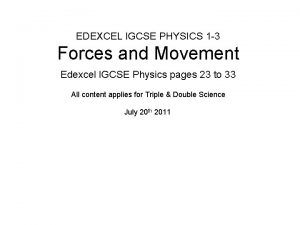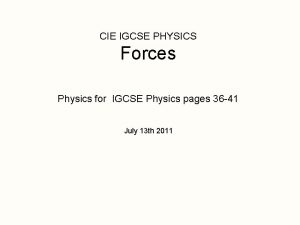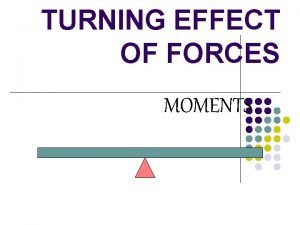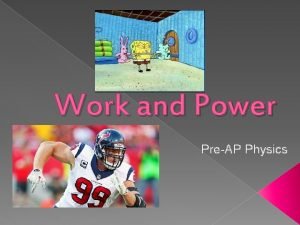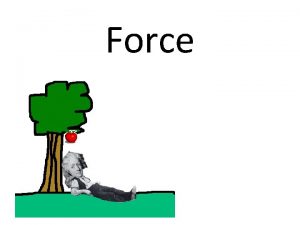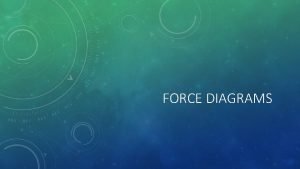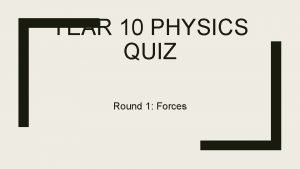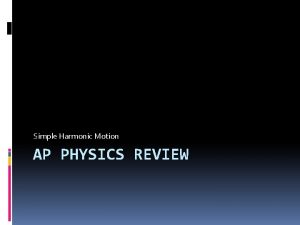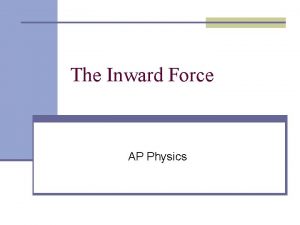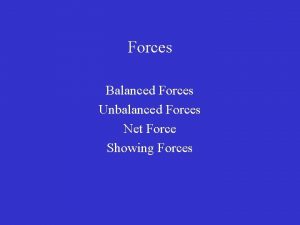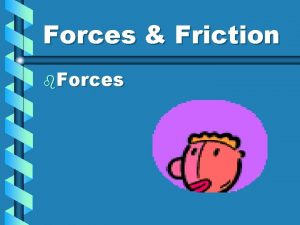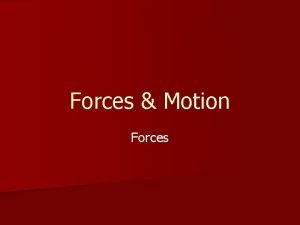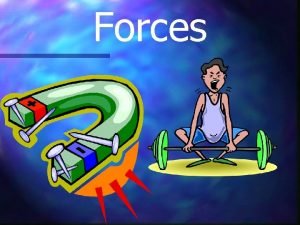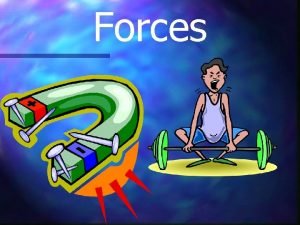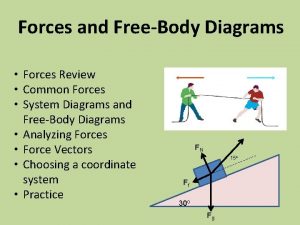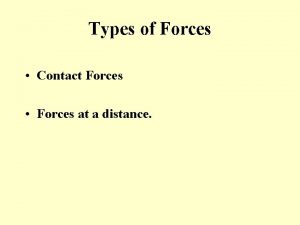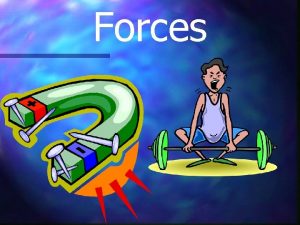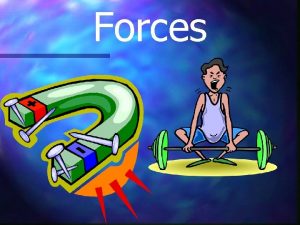Force Force in Physics Definition of force Forces





















- Slides: 21

Force


• Force in Physics • Definition of force • Forces can cause motion, but they are not always correlated with motion. The pull of gravity on a parked car does not cause motion. There are hundreds of object around us on which forces are acting, but which are not moving. • Newton stated that change of motion is caused by forces. • force is “something” which can change the state of motion. • By state of motion we understand parameters defining the motion, that is • direction • velocity • acceleration

• In physics, a force is any influence that causes an object to undergo a change in speed, a change in direction, or a change in shape. • A force has both magnitude and direction, making it a vector quantity.

• Force can also be described by intuitive concepts such as a push or pull that can cause an object with mass to change its velocity (which includes to begin moving from a state of rest), i. e. , to accelerate, or which can cause a flexible object to deform. A force has both magnitude and direction, making it a vector quantity. Newton's second law, F=ma, was originally formulated in slightly different, but equivalent terms: the original version states that the net force acting upon an object is equal to the rate at which its momentum changes. [1

• แปล • ใน ฟสกส แรงเปนอทธพลททำใหเกดการใด ๆ วตถ ทจะไดรบการเปลยนแปลงความเรวในการเปลยนแปลงในทศทางหรอเปล ยนทอยในรปราง Force can also be described by intuitive concepts such as a push or pull that can cause an object with mass to change its velocity (which includes to begin moving from a state of rest ), ie, to accelerate , or which can cause a flexible object to deform. ��������������������������� ���� (�������������� ) �����������������. A force has both magnitude and direction , making it a vector quantity. Newton's second law , F=ma, was originally formulated in slightly different, but equivalent terms: the original version states that the net force acting upon an object is equal to the rate at which its momentum changes. [ 1 ] ����� ��� ������������



• Several forces can combine to make a total, or net, force.

• The force should be equal to the summation of F 1 and F 2 force horizontal component

• For example, if one person pushed the book with a force of 20 Newtons toward the left, and the other person pushed the book with a force of 18 Newtons toward the right, then that the net force would be 2 Newtons in size and directed toward the left. Here is a picture showing those forces:

• Forces can be positive or negative. • So, to be more accurate, in the above diagram we should call F 1 a negative force, that is, negative 20 Newtons, and we should call F 2 a positive force, or positive 18 Newtons. This is shown in the following diagram. Notice that the net force is aimed to the left; so, it is a negative force.

• Two forces cancel each other. • When two or more forces cancel each other out to create a net force of 0 as in the above diagram, we say that the forces on the object are balanced.

• Forces in the same direction work together. • Also, consider the two people to be pushing the book both in the same direction. If one person pushed to the right with a force of 8 Newtons, and the other person also pushed to the right with a force of 6 Newtons, then the net force on the book would be 14 Newtons toward the right. In this case the two forces would complement each other, rather than tending to cancel each other. • This object will move as if it had a single force of 14 Newtons pushing on it toward the right.

• The net force is the vector sum of all the forces that act upon an object. That is to say, the net force is the sum of all the forces, taking into account the fact that a force is a vector and two forces of equal magnitude and opposite direction will cancel each other out. At this point, the rules for summing vectors (such as force vectors) will be kept relatively simple. Observe the following examples of summing two forces:

net force

• So what can you do with Newton's second law? As it turns out, F = ma lets you quantify motion of every variety. Let's say, for example, you want to calculate the acceleration of the dog sled shown below. • If you want to calculate the acceleration, first you need to modify the force equation to get a = F/m. When you plug in the numbers force (100 N) and mass (50 kg), you find that the acceleration is 2 m/s 2.

• Notice that doubling the force by adding another dog doubles the acceleration. Oppositely, doubling the mass to 100 kg would halve the acceleration to 2 m/s 2.

• Finally, let's imagine that a second dog team is attached to the sled so that it can pull in the opposite direction • If two dogs are on each side, then the total force pulling to the left (200 N) balances the total force pulling to the right (200 N). That means the net force on the sled is zero, so the sled doesn’t move.

• http: //zonalandeducation. com/mstm/physics/mechanics/forces/net Force/net. Force. htm • http: //www. neutron. rmutphysics. com/physicsglossary/index. php? option=com_content&task=view&id=1168&Itemi d=82 • http: //www. rmutphysics. com/physics/oldfront/75/force/index. htm • http: //www. physicsclassroom. com/class/newtlaws/u 2 l 2 d. cfm • http: //en. wikipedia. org/wiki/Force • http: //blog. tutorvista. com/2010/12/components-of-vectorforce/ • http: //science. howstuffworks. com/science-vs-myth/everydaymyths/newton-law-of-motion 3. htm • http: //ritter. tea. state. tx. us/student. assessment/resources/online/20 09/taks_g 08_science/8 Science. htm • http: //library. thinkquest. org/C 003546/ • http: //www. physicstutorials. org/home/mechanics/dynamics/newton s-laws-of-motion

• http: //www. staff. amu. edu. pl/~romangoc/M 3 -1 -force-physics. html
 What is a parallel force
What is a parallel force The forces shown above are
The forces shown above are Intramolecular vs intermolecular
Intramolecular vs intermolecular Intermolecular forces in a lava lamp
Intermolecular forces in a lava lamp Covalent bond intermolecular forces
Covalent bond intermolecular forces Contact and noncontact forces
Contact and noncontact forces Unbalanced force
Unbalanced force Destructive process examples
Destructive process examples Edexcel igcse physics forces and motion questions
Edexcel igcse physics forces and motion questions Physics 03-02 potential energy and conservative forces
Physics 03-02 potential energy and conservative forces Resultant force igcse
Resultant force igcse Turning effect definition
Turning effect definition Definition of work in physics
Definition of work in physics Physics force definition
Physics force definition Why does it happen
Why does it happen University physics with modern physics fifteenth edition
University physics with modern physics fifteenth edition Ib physics hl ia ideas
Ib physics hl ia ideas Physics free body diagram
Physics free body diagram Which of the following forces is a contact force? *
Which of the following forces is a contact force? * Restoring force physics
Restoring force physics Ap physics centripetal force
Ap physics centripetal force Find the instantaneous velocity
Find the instantaneous velocity








